S. E. Asia 2016
Early morning of November 9th in Taipei, the US election results were coming in and it looked like Florida was going for Trump. I got anxious and decided to take a walk to the nearby Museum of Fine Arts. Along the way, a man, about 40 years old speaking in English (he had studied in the US), corrected my direction as he was also heading there. He too was following the elections on his smart-phone. “It looks like Trump may win”, he said. I agreed and told him I was too nervous to watch the returns, had to walk away. “Even if he is elected, the US has checks and balances. He can’t do whatever he wants”. I reminded him that George W. Bush managed to launch a war based on flimsy and false evidence from which the world is still reeling. He agreed, “Yes, you have a point, that war was totally groundless and illegal”. The election of a President who is a bigot, a misogynist and intolerant gives me the shivers. To think that over 60 million people in an educated and powerful country voted for him is simply baffling and appalling.
Later that evening, when the election results made Trump President-Elect, to drown my sorrows, I stopped at the Malibu Bar near my hotel. I chatted with the fellow on the next stool. He turned out to be an American, about 60 years old. He had worked and lived in Taipei on and off for 20 years. He said he would not return as long as Trump remained President.
The US elections cast a shadow on my month-long visit to S.E. Asia and a pall for the few days after the results. For the first two weeks of the trip, I accompanied a Stanford University Alumni tour of Singapore, Malaysia and Thailand, to give a few lectures on the political economy of those countries. To prepare them, I read a bunch of books and other material. I will mention some in context, but for a start, Osborne’s “South East Asia: An Introductory History” provided the long perspective on the region from ancient times. At the end of the tour, I stayed on for two weeks in Thailand and stopped in Taipei for a few days on the way back to San Francisco.
Singapore
All the countries on my visit have prospered in the past few decades, but Singapore has outdone them all, indeed outdone every country in the world. By one accepted measure, it has the highest income per person of any country where people work, and don’t rely on oil resources or an offshore banking haven for their wealth. It has had a stable government with good governance that is attractive for international investors. The low level of corruption, partly fostered by private sector equivalent pay for civil servants and ministers, has helped.

Malay Singapore
Singapore has also developed world-class education institutions and physical infrastructure. Its policies, usually described as “managed capitalism”, have provided an opportunity for its population “to have a place to live in and enough to live on”. In most ways it is a perfect city-state, but the government has also been paternalistic, restrictive and even stifling at times, well portrayed in the graphic book presented by Sonny Liew “The Art of Charlie Chan Hock Chye”. With prosperity, the “big brother” governance has lightened over time.

Indian Singapore
Although Singapore is a veritable forest of gleaming, modern steel and glass high-rises, some with striking architecture, it has preserved neighborhoods belonging to its three main ethnic populations–Chinatown, Little India and Muslim-Malay—like live Disney sets, but worth wandering through. Its British colonial past is visible here and there, most notably in the Raffles Hotel, named after the modern city’s founder. I passed it on every excursion out of the Fairmont Hotel, where we lodged.
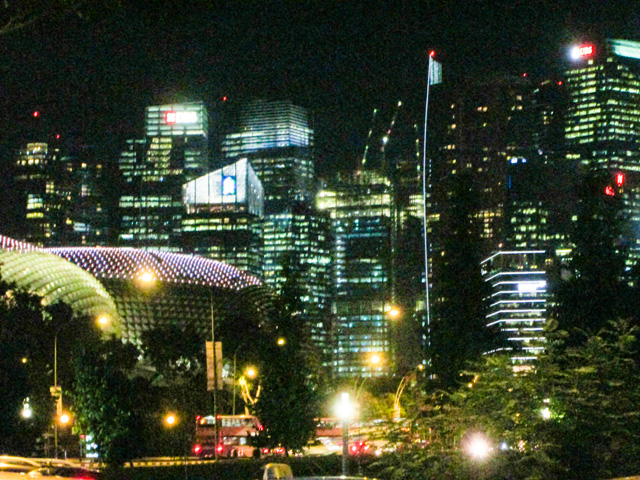
Singpore at night
Marina Bay is a spectacular development on reclaimed land that boasts structures by world-renowned architects. It includes a hotel, casino and enclosed horticultural gardens that are a wonder to walk through, flora and fauna from different climates scenically arranged in their habitat of mountains, waterfalls and humid tropics.
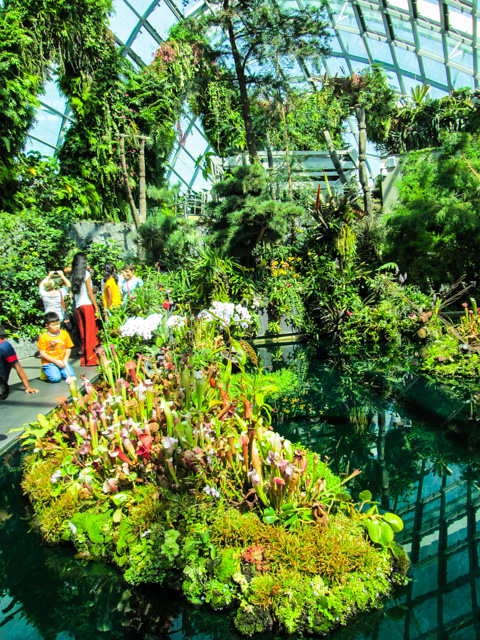
Marina Bay Singapore
I made sure to visit the Alkaff Bridge, a small span, one of many over the Singapore River, because my friend Pacita Abad, now deceased, artistically painted it. I walked through the Singapore Art Museum, but most of its galleries were shuttered to prepare for its Biennale Exhibition. The Asian Civilizations Museum, as its name implies, had artifacts representing the continent’s religious and artistic evolution. I especially liked the Buddhist sculptures from Sukothai, Gandhara, and Kushana periods and a folio painting of Emperor Akbar’s court from the Akbarnama.
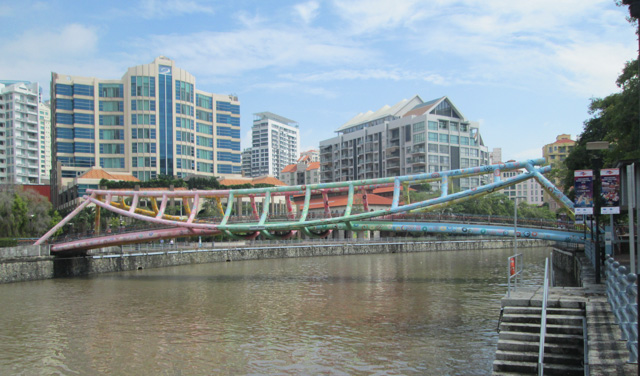
Alkaff Bridge, Singpore, painted by Pacita Abad
Placing the focus locally, the Peranakan Museum houses artifacts about, and made by, Peranakans, a term used for traders, mostly from China, but also Arabia, India and Europe, who migrated to the Straits Settlements a few centuries ago. They developed their own language, customs and dress and practiced several religions. They are known for their intricate and colorful needlework using glass beads, silk and sometimes gold thread.
All kinds of cuisines are readily available in Singapore, well beyond Singapore Noodles and Singapore Sling. We were in the city for just a couple of days so the opportunity for sampling its variety was limited. Peranakan cuisine uses Chinese ingredients with spices and techniques used in Malay/Indonesian cooking such as coconut milk, lemon grass and tamarind. PeraMakan restaurant in the Keppel Club delivered a high-quality meal in this style that included grilled eggplant with prawn sambal and prawns in spicy garam assam. We stopped at a Hawker Center, like a food court, with stalls that used to be carts out on streets. I tasted the fabled Chinese Hokkien Noodles with Shrimp, which was bland, and Indian Vadas (deep friend millet donuts), which were fully flavored with cumin seeds, curry leaves, and a dash of chili, accompanied by a coconut chutney.
Malaysia
Malaysia is a sparsely populated country that doesn’t need man-made gardens. It is a tropical paradise, lush greenery everywhere and colorful flowers blooming at the drop of a seed. It too has prospered, rising from poverty to middle income status, helped by its natural resources such as oil, tin and commercial agriculture, but held back from even greater achievement by ethnic discord between the majority Malays and minority Chinese and Indians. The preferences given to Malays and the emphasis on Islam, made obvious by the increase in women using hijabs since my last visit two decades ago, has deepened the divide.
As a symptom of the rise of religious fervor and ethnic friction, I was detained at Customs for carrying a bottle of alcohol, which is permitted for visitors, whereas my “white” American fellow traveler with the same amount of alcohol was let through without question. Could it be because I was born in Pakistan and have a surname starting with Khan, that I was taken as a Muslim and needed to be discouraged from consuming alcohol?
Rehman Rashid, a journalist and author, expresses his deep concern about Malaysia’s future in two absorbing memoirs, “A Malaysian Journey”, published in 1993, and “Peninsula”, published 2016. Despite benefiting from the preferences accorded to Malays, he observes its corrosive impact on the country, causing corruption, and deepening the racial and religious rift. Malaysia is enduring a major scandal tainted with all these elements that involves its Prime Minister.
Good novels add a deeper understanding of a society’s texture. The “Garden of Evening Mists” by Tan Twan Eng, a finalist for the Man Booker Prize, tells the story of a Chinese Malay woman from a wealthy and politically well-connected family, educated at Girton and Cambridge, who was imprisoned during the Japanese occupation of Malaya, which was harshest on the Chinese population. She lost her sister and sustained permanent physical injury. She makes her peace through an emotional involvement, the only one in her life, with a Japanese man, a former Imperial Gardner and artist, who eventually disappears. She remains an outsider in Malaysian society despite rising to the position of a Supreme Court judge.
Preeta Samarasan in “Evening is the Whole Day” tells the story of an Indian-Malaysian family that benefited from the departure of the British to become wealthy, but the Oxford educated son, who wants a political career, be a part of Malaysia’s future, is thwarted, remains an assistant attorney general, and muddles his life into inconsequence.

Melaka View
A too-short stop in Melaka, one of the British Straits Settlements (together with Singapore and Penang), revealed its past everywhere as a desirable trading hub. Our hotel, The Majestic, was a mansion built in the 1920s on the bank of a river that traders plied in junks for centuries. It has been expanded “sympathetically”, as its website says, and furnished with period furniture and textiles.
The ruins of Portuguese structures, especially St. Paul’s and Christ churches; the bright red colored Dutch town hall; and a memorial fountain for Queen Victoria in the square in front, are the centerpieces of the town. A walk down Jonker and Herren streets, now a part of the tourist route with restaurants and shops selling kitsch, also evoke the town’s colonial past. In the vicinity, the Cheng Hoon Teng Chinese Temple, with an amalgam of Tao, Confucius and Buddhist imagery, built in the 1640s, is the oldest functioning temple in the country. Nearby are a mosque and a Hindu temple, symbolic of the three religious currents in Malaysia.

Petronas Towers, Kuala Lumpur
A two-hour drive got us to Kuala Lumpur, a bustling city of 7 million people with many gleaming high-rises and traffic congestion below. We lodged in the Grand Hyatt that had its Reception on the 39th floor and its ultra modern, spacious rooms had floor to ceiling windows, some with a view of the landmark Petronas Towers. The adjoining vast shopping center shows the country’s prosperity. By chance, from a high rooftop bar, we caught a British Royal Air Force Red Arrows (like the US Blue Angles) show circling the towers. The evening view with the lights on in the buildings and fountains at the base was spectacular.
The King’s Palace and the monumental War Memorial were imposing, but the Islamic Arts Museum, set in a botanical garden, was the jewel of the city tour. Its splendid architecture, colorfully decorated domes and open galleries made walking through and viewing a pleasure. I especially liked the Moghul miniatures and Persian rugs. Purple Cane, a tea themed Chinese restaurant, served for lunch the best house-made creamy, melt-in-your-mouth tofu I’ve ever tasted. At dinner, Bijan served typical Malay Kampung (village) cuisine, which was good, but I was not able to retain the unfamiliar names or spice combinations.
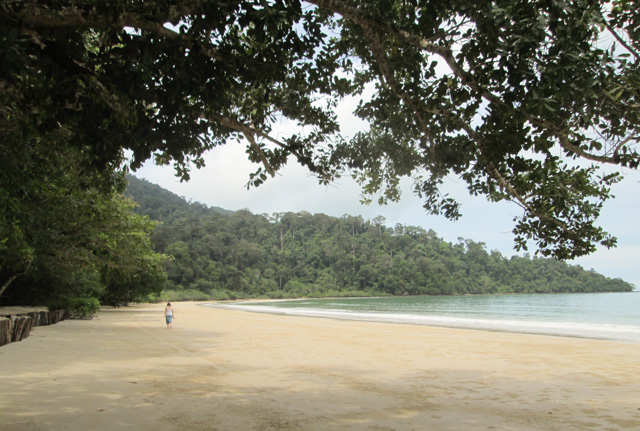
Datai Beach, Langkawi Island
A short flight got us to Langkawi Island, and a 40 min drive to the Datai Hotel situated on a hill and nestled in a rain-forest. Its buildings are designed to unobtrusively blend into the forest, give each comfortable, modern room a feeling of being in it. Indeed, if a window is left open, monkeys dash in to empty the fruit bowl. Steps down from the edge of the main complex, and a 5 min walk on a wood-board path crossing the forest, is a private mile-long sandy beach with lazy, shallow waves of the warm, inviting Andaman Sea. Through the day, the forest is alive with sounds of birds and animals. On a nature walk around the hotel, we saw geckos, langurs, lemurs, squirrels, sea hawks and much more.
A boat ride along a twisty river through a nearby mangrove swamp and forest, with a backdrop of unusually shaped limestone mounds and hills, gave the feel of being in nature a million years ago, before humans began to interfere. A naturalist guide pointed out the animals, birds and sea life, including tiny fish that are able to walk up tree branches. On the way back, our boat went through a cave with its roof covered with bats at rest.
The hotel’s Gulai House restaurant offered “authentic Malay cuisine with a touch of Indian flavors” and pulled off that fusion well. Indeed, just the names of the dishes—banana blossom salad, tiger prawns with bilimbi and coconut milk, sour snapper and pandan scented basmati rice—is enough to make one’s mouth water. I could definitely have stayed in the Datai for a few more days or weeks.

Penang Morning Market
Another short hop on a plane got us to Penang, the last of the three Straits Settlements. It felt familiar, like coming home, as I had visited just over a year ago. The island feels different from the rest of Malaysia, more like Singapore, but less developed and at a lower income level. Soon after independence, there was a movement to leave Malaysia and join Singapore, but it failed. Still, it has a Chinese plurality and is governed by the opposition party, and that makes a difference. We lodged at the historic and swank Eastern and Oriental Hotel on the shores of the Straits of Malacca in George Town, the state capital and a World Heritage Site.
Very early next morning, a group of us walked through the lively morning market that offers the day’s catch from the sea and produce from nearby farms. Further into the historic area are Sun Yat Sen’s residence, Little India, colorfully decorated for Diwali, and streets that housed merchants, banks and Chinese clans. We visited the “Blue Mansion”, a house built by Cheong Fatt Tze, a highly successful merchant, using architectural elements from several Chinese regions and materials from Britain, and furnished with period pieces. We dined at Homestyle, a simple restaurant in a small suburban shopping center that I had enjoyed on my last visit. I replicated that meal order for the group and they seemed to relish it as much as I did on both occasions.
Thailand
The tour’s final stop was in Bangkok at the Mandarin Oriental Hotel, my favorite, partly because I always hope to imbibe the ambience of its original colonial style building, now called the “Author’s Wing” after the many writers who lived and wrote there. I look forward to sitting on the hotel’s patio sipping an early morning coffee, looking out on to the Chao Phraya River as boats and barges chug by. Our tour-closing dinner was in Sala Rim Naam, the hotel’s Thai restaurant, accompanied by a dance from the Ramayana epic.
As I had been in the city many times, I did not accompany the tour to the usual sites. In fact, the King’s Palace area was closed because of ceremonies following his recent death. I could not resist a trip to Ayutthaya (based on Ayodhya, an ancient Indian city), about 50 miles upriver from Bangkok, and the royal seat for four centuries, from the 14th to the 18th. Now just ruins, but suggestive of magnificent structures and murals that used a mixture of styles from the earlier empires in Sukhothai and Angkor, but also influenced by the styles of China, Japan, Persia, Europe and India. As our visit was on a local holiday, the temples around the ruins were unusually busy with worshipers and mourners for the king’s passing.
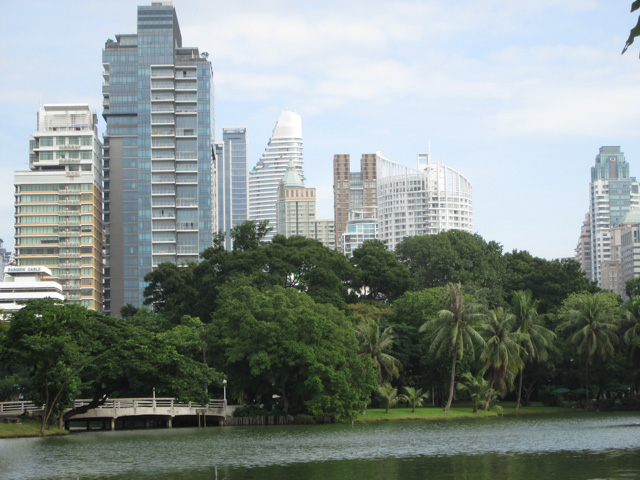
Bangkok
The core of Thai mythology is Hindu and its religion is Buddhism, both from India, albeit substantially indigenized. As I share that foundation, I feel comfortable in Thailand, indeed, more so than in India because I sense Thai culture as more considerate and compassionate. Moreover, the great Indian Buddhist Emperor Ashoka’s (300-232 BCE), whose governance (non-violence, tolerance, concern for citizens’ welfare) I am obsessed by, influenced Sukothai and Ayutthaya rulers.
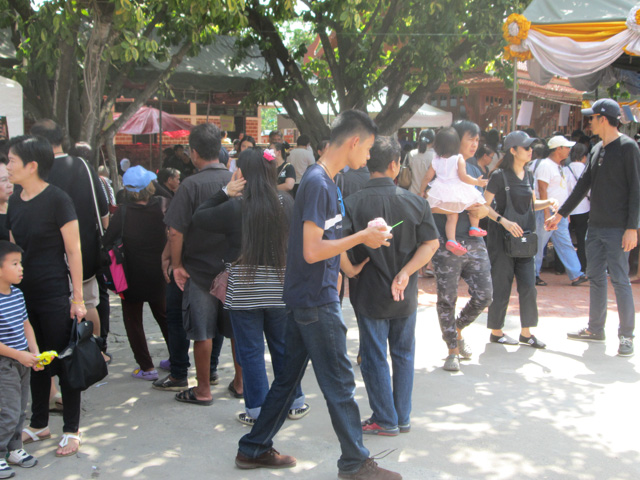
Modern Temple in Ayutthaya
That visit proved a good segue to the Prasart Museum, a private collection with temples and palaces in several styles reconstructed in smaller scales in beautifully landscaped grounds. Inside, the exhibits included pottery from 300 BCE to Khmer ceramics, Sukhothai and early Rattanakosin (current dynasty) Buddhas and other bright and intricately designed objects with red and gold as the prominent colors.
Thailand, like Malaysia, has also prospered, although not quite as much as it lacks the latter’s natural resources, and has endured a decade of slow growth because of political turmoil and uncertainty. Thaksin Shinawatra’s party has won all the elections, but he and his relatives have been prevented from ruling for long by military coups on charges of corruption and other misconduct. The decade pitted the poor from the North, Northwest and South, who supported Thaksin, against the Bangkok elite, who were opposed to him. People I talked to thought the recent public approval of a new constitution, that gives the military rulers much more power than liberal democrats would like, has settled the issue for the near future.

Breakfast at Lumphini Park, Bangkok
With the looming possibility of Trump winning the US elections, I stayed on in Bangkok for a couple weeks in search of a refuge in Asia. I have an old friend from the city that I went to boarding school with in India and college in England. I also know a couple of non-Thai people from working at the World Bank who decided to retire there.
I rented an apartment in Somerset Park in a central area (Suanplu) that had good access to public transport, supermarkets and a wonderful public park. An early morning jog or walk in Lumphini Park (Lumbini in Nepal is where Buddha was born), a circuit of about 1.5 miles, in lush greenery, beds of flamboyant flowers, bridges over ponds and statues symbolizing peace, compassion and love. Many stalls open early to provide fresh fruit or vegetable juice to hydrate runners in the heat and humidity and to have breakfast after recovering. Weekday walkers and joggers were mainly older retired people, but at weekends, the circuit was brimming with exercisers of all ages.
I set myself a few tasks to assess its services and see how I would handle the city. I had a denture relined at Bangkok Hospital, a reputed medical facility. Polite and attentive dentists completed it perfectly in three visits at about one seventh the cost in the US. I had tried to have a hundred years old desk clock, an heirloom from my grandfather, repaired in Marin County, but failed to find anyone with the right skills. Easily and well done in Bangkok at a reasonable cost. I visited the Asia Society library looking for material on Emperor Ashoka’s influence Thailand’s governance. Appropriately, it is located on Asoke Road near the Asoke Skytrain station. Sadly, I found that I had more material than they did.

Lumphini Park, Bangkok
Getting around Bangkok was fine with flexibility in the mode of transport used. The underground Metro and above ground Skytrain were easy to use and had signs and announcements in Thai and English. Younger staff spoke enough English to assist with ticketing and routes. Some destinations were far from stations, however. To reach them, taxis were readily available and cheap, but the traffic could be horrific. The quicker, and riskier, alternative is to hop a ride on the back portion of a motorbike seat. Bikers offering this service wear orange vests, like on construction sites, and stand around metro stations. Often there is a line for rides, especially during rush hours, as people want to get to work or home quicker than in a taxi stuck in traffic.
I spent a few days in Hua Hin, the Royal Beach resort that is not overrun by tourists like Phuket. A two-hour bus ride on a good road through small towns got me there. Hua Hin turned out to not be that small and is lined with many resorts and hotels along the sea, including several international brands. I stayed at the Amari, a Thai international chain. It was comfortable and the service was excellent as in most Thai establishments. But the beach at the resort was a bust. The sea came up to the hotel’s frontage wall; the water was muddy and uninviting; and the warning of jellyfish put a kibosh on swimming. Apparently, the tides are high at this time of the year. I was told I had to take a taxi for miles to reach a sandy beach.
The hotel managed an adjoining condominium, as do many other resorts. People from Europe, who come to get sunshine, warmth and good food, own many of the flats. I talked to a lady from the UK who spends four or five months a year there to get relief from the grey skies and drizzle at home. A high standard of services has developed to cater for the substantial expatriate community. I befriended a Thai garment factory owner and his driver-friend staying at the Amari who guided my wanderings and eating. Luckily, the town was interesting enough to walk around, lots of hustle and bustle, and many markets, including a night market that offered fresh seafood.
Bangkok offers a dizzying number of choices for eating. Streets and covered markets are lined with food stalls, supermarkets have food courts and there are innumerable restaurants, ranging from tiny and simple to large and posh, that offer mainly Thai cuisine, but also European and other Asian as well.
The highlights of my culinary adventures were a good dinner with a variety of Thai food at the Oriental’s Sala Rim Naam, but it catered to an entirely tourist clientele; a piquant salad containing an unusual combination of shrimp and eggplant at Watercress in K-Village Shopping Center; crisp spring rolls from a stall in Eathai, a food court in Embassy Shopping Center; a shrimp omelet and pad thai at the tiny Uncle John; and an outstanding, silk smooth coconut curry with crab, basil and dill in the renowned Nahm. I wasn’t as lucky for my second visit when I was disappointed with their tiger shrimp in a tamarind sauce. A similar dish was much better at the simple Sang Thai Seafood Restaurant on a pier in Hua Hin where I also had best tom yum soup that I can remember.
The wine taste-price value was poor in Thailand because of high taxes. While browsing a couple of wine stores, I hardly recognized a single label even though the countries of origin were familiar—New Zealand, Australia, France, Italy–probably a result of a market segmentation strategy. After recently acquiring a taste for zesty pale ales made by micro-breweries in the US, the local Tiger lager beer did not satisfy.
Yes, I could easily live in Thailand for a prolonged period.
Taiwan
My airline ticket was routed through Taipei, a city I had not visited. I spent a few days there and was impressed by its level of development. It has a higher income per person than any other S.E. Asian country except Singapore, and also higher than S. Korea, which is a member of the OECD, the club for rich countries. (Taiwan cannot join as it is considered a province of China, not separate country.) I am in awe of S.E. Asia’s progress because the region was as poor or worse than India in 1950, but now has eradicated poverty (except Myanmar, Laos and Cambodia) and provided the opportunity for tens of millions of its people to vastly improve their lives and move into the world of smart-phones in a big way.

Taipei 101
Taipei is not architecturally attractive. Unlike Singapore, Kuala Lumpur or Bangkok, it has just one remarkable building. Taipei 101 is built in the vertical pagoda style (rather than the receding style, where each level is smaller than the one below). I took the elevator up to the Observation Deck on the 89th Floor and noticed only a few other high-rise buildings and they were shaped like rectangles of different widths and heights. From street level too, buildings are not impressive, simple designs usually painted in drab colors. In contrast, the mall below the tower, and others I passed by, have all the plush major brands brightly presented.
Getting around the city was really easy on the metro, which runs frequently and announcements and signs are in Mandarin and English. In asking for directions or advice, approaching younger people yielded better results, as they seemed to know enough English to be helpful. The city is criss-crossed by rivers, but the main sites for visitors were not near any of them. There are a few large parks, and my comfortable, boutique hotel, the Riviera, was near Taipei Expo Park, among the largest.
I visited several museums and temples, some located near my hotel. The Taipei Fine Arts Museum had an exhibit of black and white photographs of Taiwan in the 1970s to remind viewers how far the island has come. Some were marvelous, captured people and places of the era, but there were too many photos, which detracted from appreciating the great ones. The Museum of Contemporary Art had exhibits by Ronald Ventura and Leigh Wen. Ventura’s works used several media for huge pieces such as a suspended wooden boat with two people, animated by a video of waves; and a collage depicting a scene after a disaster, thought provoking and eerie. Wen’s flowers, some enormous, with bright red and yellow petals, got your attention, and the long landscapes depicting fire, earth, air and water were impressive.

Leigh Wen
The city’s main museum is the Palace Museum, which houses treasures brought by Chiang Kai-Shek from China. It is an eclectic collection with some exquisite pieces, but lacks a unifying theme. I liked most the Compassion and Wisdom gallery with a several Buddha statues in metal, wood and lacquer. The afternoon I visited, it was crowded with groups and guides, each out-shouting the other in order to be heard, and the group surrounded the object, obscuring it. I thought to come back early on another day, which I did, but it was even more crowded. The management needs to stream visitors to allow them to view, read and appreciate the displays.
Among the temples, Lungshan, dedicated mainly to Buddhism, but also other Chinese deities, had the most impressive compound and was also the most active with worshipers. It’s in a historic neighborhood with narrow lanes and small shops offering all sorts of goods, including cooked food. The Baoan Temple, dedicated to a saint known for his medical skills, was an elaborate complex, but not quite as active. The nearby Confucius Temple was a modern structure with few visitors, but informative about Confucius and his disciples. The Chiang Kai-Shek memorial, fronted by a huge square and flanked by two large concert halls, had the aura of a temple from the distance, but entry was forbidden.
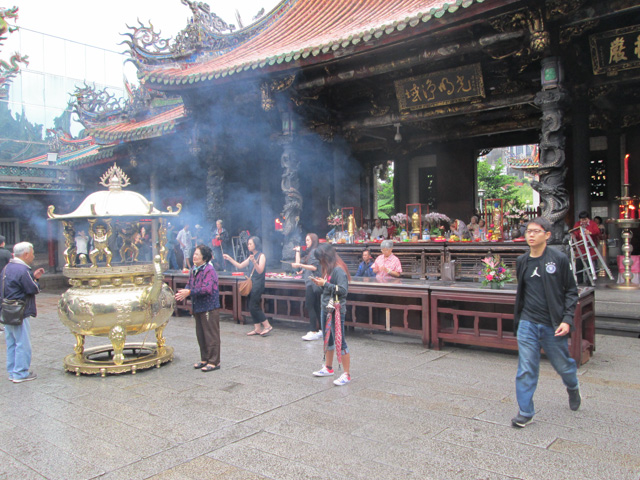
Lungshan Temple, Taipei
Taipei is known for its dumplings and food markets. Advised by a food blogger, I made an effort to sample as many as I could. My best experience was at Din Tai Fung, an internationally known restaurant. I ate at two of its locations, the original small restaurant, up two flights of stairs, and a new location in the basement of a swish department store. I enjoyed most the velvety shrimp wontons that dissolved in my mouth, and the simple shrimp fried rice, light and fragrant with the unspiced, natural aroma of eggs, shrimp and scallions.
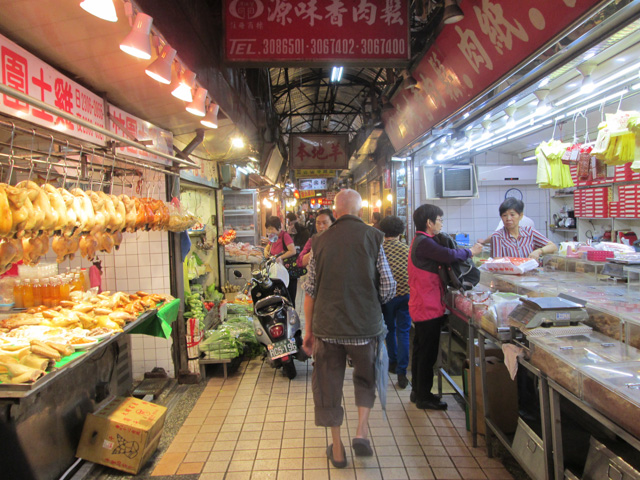
Shilin Night Market, Taipei
At the two-block long Liaoning Street market, the oyster omelet, a signature local dish and new for me, was chock full of oysters and scallions, and went down well with some chili sauce. In contrast, the Shilin Night Market with hundreds of stalls and restaurants, was too confusing for an ignorant tourist who did not speak Mandarin. The Namen Market was somewhat less confusing. I had a simply prepared crab legs salad and tasty tofu in a chili sauce. After two weeks of spicy Thai cuisine, Taipei’s food tasted delicate, but insipid, unfortunately. Taiwan is known for its whiskey and I was able to taste the prize winning single malt Kavalan, which was pretty good. The beer, however, like Thai beer, was too light for my taste.

12 Responses to S. E. Asia 2016